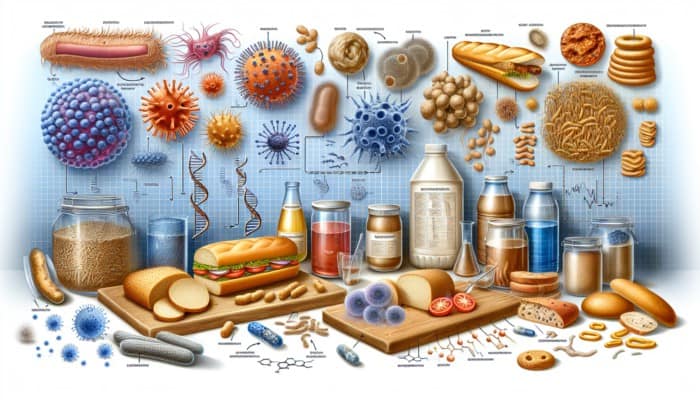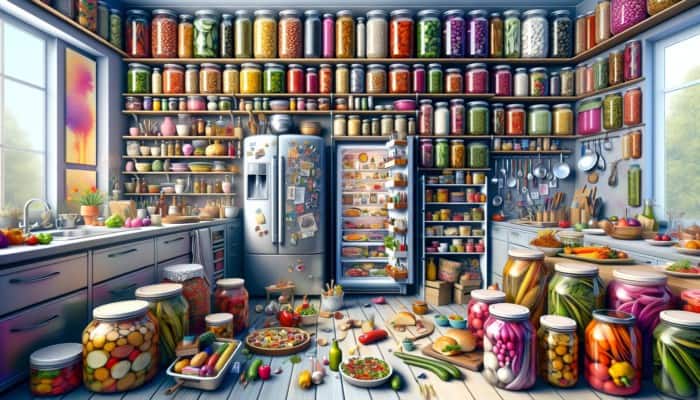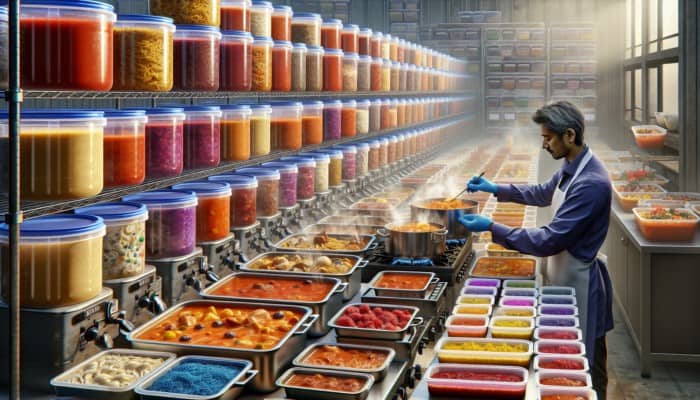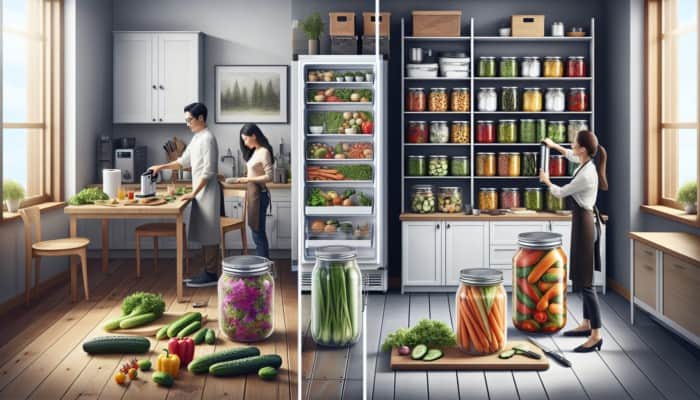Essential Food Preservation Techniques: Unlocking Freshness and Flavor
Food preservation techniques have become invaluable allies in pursuing culinary excellence and sustainability. By adopting these methods, you can delight your taste buds and contribute to environmental sustainability, ensuring that your greens remain vibrant and your leftovers avoid becoming unintentional science experiments. Let’s explore the fundamental principles of maintaining the freshness and flavor of your food, starting with an in-depth understanding of spoilage.
Key Factors Contributing to Food Spoilage: The Science You Need to Know

Spoilage is unavoidable for our cherished edibles; however, gaining insight into the science behind it equips you with the tools needed to counteract it effectively. Three primary factors contribute to food breakdown: microbial growth, enzymatic reactions, and oxidation. Microbial entities, such as bacteria, yeasts, and molds, flourish in nutrient-rich settings, making leftover pasta a prime candidate for deterioration. Essentially, the more moisture and warmth present, the faster the spoilage occurs.
Enzymatic activity plays a significant role in this narrative. Enzymes, which are natural proteins, facilitate the ripening of fruits and vegetables. However, once food reaches its peak ripeness, these enzymes can initiate a decline in quality. Conversely, oxidation refers to the chemical reaction between oxygen and food components, often leading to fat rancidity and fruit browning.
By grasping these fundamental concepts, you can implement effective food preservation techniques that significantly extend the shelf life of your ingredients. Every proactive measure you take, from managing moisture levels to utilising airtight containers, contributes to enhancing freshness and flavor.
Optimal Temperature Settings for Food Preservation: Best Practices for Your Refrigerator and Freezer
Temperature is your most reliable ally in the battle against spoilage. Maintaining your refrigerator at a steady temperature of approximately 4°C (39°F) is crucial for slowing microbial growth. It is a delicate fine balance; if the temperature is too warm, you may invite a bacterial invasion, while if it’s too cold, you risk freezing your delicate herbs.
Aim for freezer temperatures of -18°C (0°F) or lower. This specific temperature effectively halts microbial activity while preserving essential nutrients. However, it’s just as important to consider how you store food in these chill zones. Utilising airtight containers or heavy-duty freezer bags is essential to prevent freezer burn, a notorious enemy that can diminish food quality in flavor and texture. Remember to label and date your frozen items, transforming your freezer into a well-organised culinary time capsule rather than a mysterious abyss.
By mastering temperature regulation, you’ll prolong the freshness of your food and enhance the overall quality of your meals.
Humidity Management: Strategies for Keeping Your Produce Fresh and Crisp
Humidity plays a crucial yet often overlooked role in preserving produce. The key lies in striking the perfect balance between excessive dryness and overwhelming moisture. High humidity levels can foster mold growth, while low humidity can lead to desiccation, turning fresh carrots into sad, shriveled sticks.
To effectively manage humidity, utilise your refrigerator’s crisper drawers, which typically come with adjustable settings. Wrap them in a damp paper towel for leafy greens to maintain moisture without creating a soggy environment. Additionally, consider investing in humidity-control packs or DIY solutions, such as placing a small water bowl in your fridge to help regulate moisture levels.
Keep fruits separate from vegetables to minimise exposure to ethylene gas, which can accelerate ripening and spoilage. Apples, bananas, and avocados are notorious ethylene producers, so designate a specific area to prevent unwanted spoilage.
By mastering humidity control, you’ll ensure your produce remains vibrant and crisp, ready to enhance any dish with fresh flavors.
Creative Food Preservation Strategies for Busy Households

In today’s fast-paced environment, time is of the essence, and innovative food preservation strategies can make all the difference between a home-cooked meal and a last-minute takeout option. Let’s delve into some ingenious techniques tailored for busy households, ensuring you always have delicious, ready-to-eat meals without the hassle.
Quick Pickling: A Fast and Flavorful Way to Preserve Vegetables
Quick pickling is a culinary magician’s trick, transforming ordinary vegetables into zesty delights. This method involves immersing vegetables in a solution made of vinegar, water, salt, and sugar, allowing them to absorb flavor while prolonging their lifespan. The process is remarkably straightforward: slice your chosen vegetables, boil the pickling solution, and pour it over the veggies in a clean jar.
Homemade pickles can be enjoyed within one day and last for weeks in the refrigerator. Think cucumbers, carrots, or red onions—they are ideal for elevating salads, sandwiches, and charcuterie boards. This technique is a fantastic way to use wilting vegetables before they end up in the compost bin.
Quick pickling imparts a burst of flavor and encourages creativity in the kitchen. Feel free to experiment with various spices and herbs to tailor your pickling solution, transforming your refrigerator into a treasure trove of tangy treats.
Freezer Meals: Simplifying Meal Planning and Preparation for Time-Saving Convenience
Imagine arriving home after a long day to find a delicious home-cooked meal. Enter freezer meals, the ultimate time-saving approach for busy households. You can batch-cook and freeze meals ready to reheat whenever hunger strikes by dedicating just a few hours to meal preparation.
Start by selecting recipes that freeze well, such as casseroles, soups, and stews. Cook in bulk, portion the meals into freezer-friendly containers, and label them with the date and contents for easy access. When hunger calls, grab a meal from the freezer, pop it in the microwave or oven, and voilà—dinner is served!
This strategy saves you valuable time and minimises food waste—no more half-used ingredients languishing at the back of your refrigerator. Plus, you’ll find it easier to resist the temptation of takeout, knowing that a hearty, home-cooked meal is just minutes away.
Batch Cooking: Efficiently Preparing Large Quantities of Food for Future Enjoyment

Batch cooking is the superhero of meal prep, enabling you to prepare large quantities of food in a single session. It’s efficient, economical, and a brilliant way to ensure you always have nutritious meals readily available.
Begin by selecting recipes well-suited for batch cooking—think hearty stews, pasta sauces, and stir-fries. Dedicate time on the weekend to cooking in bulk, portioning your creations into airtight containers, and storing them in the refrigerator or freezer.
This approach streamlines your weekday meal prep and helps you manage portion sizes, fostering healthier eating habits. Furthermore, it encourages culinary creativity—mix and match ingredients to keep your meals exciting, ensuring you never grow tired of the same offerings.
Batch cooking captures the essence of food preservation techniques, transforming your kitchen into a sanctuary of convenience and flavor.
Comprehensive Guide to Food Preservation Techniques: Natural Methods for Waste Reduction
As we navigate the complexities of modern life, embracing natural methods of food preservation becomes an essential practice. With sustainability in mind, let’s examine three powerful techniques designed to reduce waste while enhancing the flavors of your food.
Fermentation: Unlocking the Benefits of Beneficial Bacteria for Food Preservation
Fermentation is an age-old technique that preserves food and boosts its nutritional content. By harnessing the power of beneficial bacteria, you can create probiotic-rich foods that promote gut health while extending shelf life.
The fermentation process begins by introducing beneficial bacteria to your food, often through a starter culture or naturally occurring microbes. Commonly fermented foods include sauerkraut, kimchi, and yogurt. The magic unfolds as these bacteria consume sugars and produce lactic acid, creating an environment where harmful bacteria cannot flourish.
Fermentation is accessible and requires minimal ingredients and equipment. Chop your vegetables, mix them with salt, and let them ferment in a clean jar. The result? A tangy, flavorful product that can last for months in your refrigerator—delicious on its own or as a complement to various dishes.
Dehydration: A Simple Method for Preserving Fruits, Vegetables, and Herbs Without Additives
Dehydration is a straightforward technique for preserving food while retaining its flavor and nutrients. Removing moisture effectively inhibits the growth of spoilage-causing microorganisms, allowing you to enjoy seasonal produce long after harvest.
You can dehydrate food using a dehydrator or an oven or air-dry herbs. Slice fruits and vegetables evenly to ensure consistent drying. For herbs, tie them in bunches and hang them in a warm, dry location. The outcome is concentrated flavors that can be used in cooking, snacking, or as flavorful garnishes.
Not only does dehydration extend shelf life, but it also reduces food waste. Imagine transforming a surplus of apples into delightful dried chips or overripe tomatoes into sun-dried delicacies. The possibilities are truly endless!
Canning: A Time-Tested Technique for Long-Term Food Storage
Canning is a traditional preservation method that has proven its worth over time. This technique involves sealing food in airtight jars and heating them to eliminate the bacteria and enzymes that cause spoilage.
Adhering to proper safety protocols is vital to prevent health risks when canning fruits, vegetables, or sauces. Invest in quality canners and jars, and ensure they are sterilised before use. The beauty of canning lies in its versatility; you can enjoy your garden’s bounty year-round, transforming seasonal produce into delectable preserves.
From homemade jams to pickled vegetables, the satisfaction of opening a jar of your creation in the winter months is unmatched. Canning not only prolongs the shelf life of your food but also celebrates the joy of home cooking, allowing you to savor the season’s flavours long after they have passed.
Modern Food Preservation Techniques: Utilising Technology and Gadgets
Modern tools can revolutionise how we preserve food in an era of rapid technological advancements. With innovative gadgets, let’s explore how technology enhances food preservation techniques for the contemporary kitchen.
Vacuum Sealing: Effortlessly Extending the Shelf Life of Your Food
Vacuum sealing is a groundbreaking method for food preservation. By removing air from bags or containers, you significantly decrease the risk of spoilage, keeping your food fresher for an extended period.
This technique is particularly effective for meats, cheeses, and dry goods. Place your food in a vacuum-sealable bag, utilise the vacuum sealer to extract the air, and seal it shut. The result is an airtight environment that inhibits bacterial growth and oxidation.
Vacuum-sealed food can remain fresh up to five times longer than traditionally stored items. Plus, it’s incredibly versatile; use it for marinating meats, sous vide cooking, or storing bulk items. Embrace vacuum sealing and elevate your food storage practices to new heights.
Smart Refrigerators: How Advanced Technology Can Assist in Monitoring and Preserving Your Food
Welcome to the cutting edge of food preservation: smart refrigerators! These high-tech appliances have features that enable you to monitor your food inventory, track expiration dates, and even suggest recipes based on what’s inside.
Imagine receiving notifications on your smartphone when your milk is nearing its expiration date or when it’s time to use that leftover roast. Smart refrigerators help minimise food waste and ensure you utilise your ingredients efficiently.
Some smart refrigerators even allow you to remotely control temperature and humidity settings, guaranteeing optimal conditions for preserving your food. With these innovations, your refrigerator can become a proactive partner in your culinary adventures.
Sous Vide Cooking: A Precise Technique for Preserving the Quality of Your Meals
Sous vide cooking is a precise method that involves sealing food in vacuum-sealed bags and cooking it in a water bath at a controlled temperature. This technique maintains the quality of your ingredients, locking in flavors while ensuring even cooking.
The sous vide method enhances the taste and texture of your meals and prolongs their shelf life. Cooking in a vacuum-sealed environment minimises exposure to air, reducing the risk of spoilage.
Sous vide is perfect for meal prep; you can cook and freeze large batches for future enjoyment. When you’re ready to eat, reheat your sous vide meal, and you’ll indulge in restaurant-quality dishes right at home.
Embracing sous vide cooking offers a culinary time machine, allowing you to preserve the quality of your meals while effortlessly enjoying gourmet flavors.
Essential Food Preservation Techniques for Eco-Conscious Consumers
As awareness of environmental issues grows, sustainable practices in food preservation have become vital. Let’s explore practical strategies that minimise food waste and contribute to a healthier planet.
Minimising Food Waste: Strategies for Reducing Your Environmental Footprint
Minimising food waste is a crucial aspect of sustainable living. One of the most effective strategies is to plan your meals carefully. Create a shopping list based on your needs and adhere strictly to it to avoid impulse purchases that may go to waste.
Additionally, repurpose leftovers creatively. Transform yesterday’s roast into a hearty soup or use stale bread to make croutons. Embrace innovative cooking techniques, and you’ll discover countless ways to utilise what you have before it spoils.
Educating yourself about proper food storage methods is equally important. Understanding the best techniques for storing fruits, vegetables, and leftovers can significantly extend their shelf life and reduce waste.
Implementing these strategies will not only lessen your environmental impact but also nurture a more mindful approach to food consumption.
Composting: Converting Food Scraps into Nutrient-Rich Soil for Your Garden
Composting is an excellent way to transform food scraps into nutrient-rich soil, effectively closing the loop on food waste. By composting, organic waste is diverted from landfills, where it would otherwise contribute to harmful greenhouse gas emissions.
Begin by establishing a compost bin in your garden or kitchen. Collect vegetable peels, coffee grounds, eggshells, and other organic materials. Layer them with browns, such as dried leaves and cardboard, to create a balanced compost mixture.
Over time, these scraps will decompose into rich, dark compost that can nourish your garden. Composting reduces waste and enhances soil, promoting healthy plant growth and minimising the need for chemical fertilisers.
Embrace composting as a sustainable practice that benefits both your kitchen and your garden, creating a beautiful cycle of nourishment.
Upcycling: Creative Ways to Repurpose Leftover Ingredients and Reduce Waste
Upcycling is the art of transforming leftover ingredients into something new and exciting. Instead of discarding those wilting greens or overripe bananas, unleash your creativity!
For instance, turn stale bread into breadcrumbs or croutons. Use vegetable scraps to create a flavorful broth or blend overripe fruits into refreshing smoothies. The possibilities are limitless when you cultivate a mindset of creativity in the kitchen.
Moreover, consider incorporating this philosophy into your cooking routine. Plan meals that consciously use up ingredients nearing their expiration dates, ensuring nothing goes to waste while delighting your palate.
By prioritising upcycling, you foster a sustainable kitchen that celebrates resourcefulness, creativity, and deliciousness.
Tailored Food Preservation Techniques for Specific Food Types: Customised Solutions for Your Kitchen
Every food type has unique characteristics when it comes to preservation. Understanding these nuances can help you tailor your strategies for maximum effectiveness. Let’s delve into how to preserve specific food types with targeted techniques.
Preserving Fresh Herbs: Techniques to Maintain Vibrancy and Flavor
Fresh herbs can elevate any dish, but they often wilt before you can fully appreciate their potential. Consider several effective techniques to preserve your herbs’ vibrancy and flavour.
One popular method involves freezing herbs in olive oil. Chop your fresh herbs, mix them with olive oil, and pour the mixture into ice cube trays. Once frozen, transfer the cubes to a freezer bag for easy access. These flavor-packed cubes can be added directly to soups, stews, or sauces, infusing your dishes with fresh herb goodness.
Alternatively, you can dry herbs by hanging them upside down in a well-ventilated area. Once dried, store them in airtight jars, preserving their flavor for months.
By mastering the art of herb preservation, you’ll always have fresh flavors at your fingertips, enhancing your culinary creations.
Extending the Shelf Life of Dairy Products: Effective Tips for Storing Milk, Cheese, and Yogurt
Dairy products can pose challenges when it comes to preservation, but with a few simple hacks, you can significantly extend their shelf life. To maintain freshness, store milk in the coldest section of your fridge, ideally at the back.
Cheese benefits from being wrapped in parchment paper before being placed in an airtight container. This approach allows it to breathe while preventing it from drying out. Consider adding a small piece of wax paper to absorb excess moisture for soft cheeses.
Yogurt can also be preserved effectively by keeping the lid tightly sealed and storing it away from strong-smelling foods to maintain its delicate flavor.
These tips will ensure your dairy products remain fresh and enjoyable for longer, reducing waste and enhancing your meals.
Preserving Bread and Baked Goods: Techniques to Keep Your Baked Treats Fresh
Bread and baked goods can quickly become stale, but using the right preservation techniques keeps them fresh and delicious. To maintain its crusty exterior, keep bread in a paper bag at room temperature for short-term storage.
When it comes to longer storage, freezing is your best option. Slice the loaf before freezing, enabling you to pull out individual slices as needed. Wrap the bread tightly in plastic or foil, then place it in a freezer bag. When you’re ready to enjoy, simply toast or thaw at room temperature.
Baked goods like cookies or cakes should be stored in an airtight container to retain moisture. If they are frosted, consider refrigerating them to prevent melting.
By mastering these preservation techniques, you can savor your favorite baked treats without worrying about them going stale.
Common Questions About Food Preservation Techniques: Addressing Your Concerns
How Long Can I Safely Store Different Types of Food?
The duration of safe storage varies by food type. Generally, most meats can be frozen for 6-12 months, while fruits and vegetables last around 8-12 months in the freezer. Always consult specific guidelines for each type of food.
What Are the Signs of Spoilage, and How Can I Prevent Foodborne Illness?
Common spoilage indicators include off smells, changes in texture, and visible mold. Practice proper food storage, hygiene, and cooking techniques to prevent foodborne illness.
Can I Combine Different Preservation Methods for Better Results?
Absolutely! Combining methods can enhance preservation. For instance, you can pickle vegetables and then vacuum seal them, extending their shelf life while adding flavor.
How Do I Know If My Canning Process Was Successful?
A sealed lid that doesn’t pop when pressed indicates a successful canning process if the lid flexes, the jar may not be adequately sealed and should be refrigerated and consumed soon.
Can I Freeze Leftover Canned Food?
Yes, you can freeze leftover canned food. Transfer the contents to an airtight container before freezing to prevent freezer burn and preserve quality.
What Is the Best Way to Store Leftover Takeaway Food?
Store leftover takeaway food in airtight containers in the refrigerator. To ensure food safety and quality, consume within 3-4 days.
Can I Preserve Cooked Food, and How Long Does It Last?
Yes, cooked food can be preserved by refrigerating or freezing it. In the fridge, it lasts 3-4 days; in the freezer, it can last 2-6 months, depending on the type of food.
Is It Safe to Eat Food Past Its Expiration Date?
Not all foods are unsafe past their expiration date. Check for signs of spoilage; if they look and smell fine, they may still be safe to consume within a reasonable time frame.
How Can I Tell If My Food Has Been Frozen?
Dry, discolored patches on food characterise freezer burn. While the food is safe to eat, the affected areas may have a stale taste and texture.
What Should I Do with Food That Has Spoiled?
Dispose of any spoiled food immediately to prevent contamination of other food items. Composting is an eco-friendly option for organic waste.
Explore our world on X!
Food Dehydration Tips: Essential Techniques
Discover the Advantages of Food Dehydration for Health and Sustainability Preserving Nutritional Value Effectively Food Dehydration Tips: Food dehydration is one of the most efficient techniques for preserving the vital nutrients in a variety of foods. This process not only removes excess moisture but also effectively locks in essential vitamins and minerals, preserving the food’s nutritional […]
Edible Plant Safety: A Universal Guide
Understanding Edible Plant Safety: A Comprehensive Guide What Exactly Are Edible Plants? Edible Plant Safety: Edible plants encompass a diverse range of fruits, vegetables, herbs, and other plant parts that are safe for human consumption. Knowing what qualifies as an edible plant is crucial for ensuring safety, particularly for those interested in foraging or incorporating wild […]
Blizzard Food Storage: Essential Tips and Techniques
Essential Steps for Preparing for Blizzard Conditions Effective Strategies for Stocking Non-Perishable Foods Blizzard Food Storage: When preparing for a blizzard, it is vital to focus on stocking non-perishable foods to ensure you have adequate sustenance throughout the storm. Such items are not only convenient but also possess a long shelf life, making them ideal […]
Freeze-Dried Food Reviews: A Comprehensive Guide
Comprehensive Guide to Understanding Freeze-Dried Foods What Exactly Are Freeze-Dried Foods? Freeze-Dried Food Reviews: Freeze-dried foods represent an impressive culinary innovation aimed at maintaining the natural characteristics of fresh produce while significantly prolonging their shelf life. The freeze-drying process involves removing moisture from food, a technique that effectively preserves both nutritional value and flavor. This method […]








Your exploration of food preservation techniques truly resonates with me. It’s fascinating to think about how much our culinary practices are intertwined with science, particularly when we consider the role of microbial growth and oxidation in spoilage. I’ve always been intrigued by the balance between enjoying fresh produce and preventing waste, a challenge that seems to grow more essential in our fast-paced world.
Your exploration of essential food preservation techniques highlights an important intersection of culinary practice and environmental sustainability, a topic that is increasingly relevant in today’s society. As someone who has experimented with various preservation methods, I find it fascinating how understanding spoilage can directly influence our approaches to food storage and preparation.
I appreciate your thoughts! It’s amazing how much we take for granted with food and how our storage habits can shape not just our meals but our impact on the environment. When I started playing around with preservation methods, the learning curve was eye-opening. For example, learning about fermentation really brought home how spoilage is just the flip side of a process.
It’s really interesting how much our storage habits can influence not just what we eat, but also our relationship with food. When I first dabbled in fermentation, I felt the same way—like I was unlocking this whole ancient world of food preservation that we seem to have drifted away from. It’s funny to think that many people view spoilage as a failure, while fermentation is all about embracing that natural process in a way that creates something new and delicious.
You’ve hit the nail right on the head with that observation about food storage and our relationship with what we eat. It’s wild to think that a simple jar of cabbage can morph into a tangy, probiotic powerhouse, while the same cabbage languishing at the back of the fridge might just be a sad, wilted victim of neglect. It’s all about perspective, isn’t it?
Your exploration of food preservation techniques highlights a crucial yet often overlooked aspect of both culinary practices and environmental sustainability. Understanding the key factors that contribute to spoilage—microbial growth, enzymatic reactions, and oxidation—truly equips individuals with a foundational knowledge that can make a significant difference in food management.
You bring up a really important point about food preservation techniques and how they intertwine with both culinary practices and environmental sustainability. I’ve always been fascinated by the science behind spoilage, especially considering how much food goes to waste every year. It’s astonishing to think that simple techniques like fermentation or pickling not only extend the shelf life of food but also enhance flavors and nutrients.
I really appreciate how you’ve highlighted the importance of understanding spoilage in relation to food preservation techniques. It’s something we often overlook while we’re busy whipping up meals or trying to make sure our groceries last through the week. I remember when I first started getting into canning and preserving—what a journey that has been! It’s fascinating to think about how food preservation is really a blend of art and science, isn’t it?